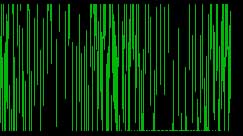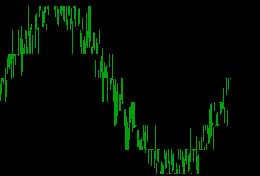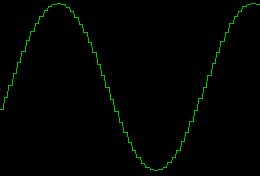
Conversion Techniques
R2R
In the CD-format chapter you have seen that digital numbers are translated into a staircase signal, and by rounding the steps, we get something that pretty much resembles the originally captured signal.
This translation process from numbers into voltage steps, is what happens in a R2R DA converter which is sometimes also called a "ladder-DAC" or "multibit-DAC", as resistors (the R's in R2R) are configured as an ascending series of voltage dividers.
Such a R2R converter is a static device, in that it is able to generate a clean voltage (with 16 bits resolution there are 65536 different voltages) and hold that voltage until another number is converted, or if numbers repeat - for an infinitely long time, while maintaining an extremely low noise level.
In order to achieve a certain level of performance, the resistors (R's) inside the converter chip must be precisely trimmed, which can make a device very expensive to manufacture, especially when true 24-bit resolution is required.
Some companies are famous for their R2R converter chip designs, such as Analog-Devices, Burr-Brown and Philips.
The 'El-Cheapo' Method
In order to avoid the required precision in the manufacture of R2R converters (and save manufacturing costs), another conversion technique became very popular.
In this conversion technique, a single switch replaced the precision resistors of the R2R DAC, and it was believed (and shown to a certain extent) that if only the switch was toggled fast enough, one could also achieve many different voltages.
If for example the switch is more often switched to 5V than to 0V, and if that switch-signal is run through a low-pass filter then the output voltage will also be closer to 5V, than to 0V, plus lots of noise.
This fast switching technique is employed in sigma-delta conversion and it is also the technical foundation of the newly introduced SACD or DSD format.
As a 16 bit R2R DAC is able to generate 65536 different static voltages, and a single switch can only generate 2 different voltages (hi and low), a high switching frequency (usually in the range of a couple of MegaHertz, and achieved through oversampling) is necessary for proper operation and thus, much noise will be produced by the switching process in a sigma-delta converter.
In fact, for any practical application, the noise-level is much higher than the signal that is to be reproduced.
Therefore, this inacceptable high noise-level is shaped into higher-frequencies, as it is believed that high-frequency noise is outside the human listening range and will not degrade sound quality.
As a side effect of this high-order noise-shaping even higher noise levels are generated, residing in the high-frequency region.
To our surprise, in the technical specification of those sigma-delta DACs very low noise-levels are mentioned, and by reading the data-sheets, one could have the illusion, that a decent sound quality would be attainable by such a device.
In fact, the total noise-output is never stated in the data-sheets, and measurements only mention in-band-noise up to 20kHz, suggesting that higher frequency noise has no effect on fidelity.
Of course with this eye-closing practice only those can be fooled that also have closed ears.
In plain english: sigma-delta DACs are coarse noise-generators and when measured the way they should be measured they never make it to 16-bit resolution, don't even think about 24 bits.
As some engineers realized that the el-cheapo method did not lead to satisfying fidelity, because with 1-bit switching performance the quantization noise level was just too much, new converters came up, being called "multi-level sigma-delta".
By increasing the number of voltages from 2 (1-bit) to 5 or more (multi-level), the quantization noise could be reduced.
As this was still not satisfactory, some companies started introducing more levels and coined the term "multibit sigma-delta), as they now use 32 or 64 voltage- or switching-levels, which make up 5 or 6-bits.
Now imagine how much money was spent in research & development to make DA-converter chips cheaper, and in the end just finding out, that more and more levels - more resolution - has to be introduced in order to make them listenable.
Just have a short break to think about it.
The more levels you introduce to sigma-delta - the more bit resolution you realize, the better it gets. Where does that lead to ?
Exactly.
It leads just all the way back to R2R converters, which have high-resolution, high accuracy and very low noise.
The Looks
See below the unfiltered output of a 1-bit sigma-delta DAC, respectively DSD/SACD:

This is supposed to be a sinewave.
Following is the output of a 3-bit (multilevel) sigma-delta DAC.

Well, now you can estimate, it wants to be a sinewave ;-)
And now, take a look at a good old 16-bit R2R DAC:

Don't be afraid, to relate what you see to what you expect to hear.
The key issue that I want to address here is noise. A R2R DAC can convert noise-free, whereas any sigma-delta DAC relies on the noise in order to randomly shape the immense quantization error.
Even if the noise is technically specified to be outside the human listening range, and also specified to be easily filtered away, any real-world implementation of any sigma-delta DAC will tell your ears a different story.
And Soundwise ?
In science, the experiment decides if a theory is held valid or discarded.
This is of course difficult when a sound quality is subjectively assessed, as science only deals with instruments, as the experiment for being considered valid, must be repeated consistently.
This is the core of all arguments of the following type:
A: It is flawless and perfect in any scientific, engineering and mathematical way.
B: But it sounds so bad.
or the other way:
A: You cannot do that at all. It is totally wrong and you can measure numerous kinds of distortion.
B: Hey, now its just right. This is the way a saxophone sounds :-)
Subjective Evaluation
R2R/Multibit/Ladder DAC:
What I personally like with R2R converters, is their ability to reproduce a wide variety of timbres. A cymbal can really sound like a cymbal, not like crinkling a piece of paper. A piano can have body.
It is the richness and diversity of complex harmonic structures that a well done multibit or R2R DAC is able to produce, which can make it a very musical and real sounding device.
And this is the reason why I use R2R technology inside my Attraction DAC and Tera-Player!
Position of instruments is rock-stable.
Sound has balls, and at the same time precision. It can drive
If there is any sonic signature at all, it is one which could best be described as "chocolate-like".
Sigma-Delta DAC:
What I personally dislike with any sigma-delta DAC I have listened to up to now, is the lack of reproducing a voice's or instrument's timbre, and the lack of all other positive aspects of R2R DACs, as mentioned above.
Instead of being able to enjoy the richness and variety of different sounds, I have the impression that everything sounds the same, or has the same imprinted character, which could best be described as nervous fizzle.
There is no tone and no body. No balls, no precision, no transparency and no drive.
What is left is the annoying sonic signature, ranging from "acid to pink hiss".
The more levels or bit-resolution are introduced in a sigma-delta converter, the less annoying the sound becomes.
The worst sound can be achieved with 1-bit modulators, as found in DSD, respectively SACD.
Apart from SACD being a complete waste of storage space, the achieved resolution is low, and the musical presentation ranges from "very lame without detail and drive" to "more detail but very acid".
PS: For being fair, some people relate what I call "nervous fizzle" to "very wide and open soundstage". I consider this an issue of listening level, or perhaps - in better words: personal preference. To me, the realness of a musical presentation is to a large part determined by correct timbre (tone) of instruments and voices.
PPS: Recently I was able to audition a very expensive and high-performance CD-player that runs on 4x AD1955 sigma-delta converters per channel. Although that was definitely the best and smoothest sigma-delta presentation I had heard by then, I was not completely satisfied. One or two octaves were underrepresented in the lower end, soundstage was quite narrow, although none of the typical switching noise was apparent. But subjectively the worst and most consistent problem was the inability to play different timbres. Every instrument sounded the same, as if covered with a gloss of plastic, not PVC but a higher quality plastic...
PPPS: And this is the reason why I completely avoid Sigma-Delta technology in any and all of my audio products.
Okay, that was enough
Lets focus on something positive: There are still R2R DACs available.
Texas Instruments offers some great R2R DACs that were developed by Burr-Brown. The flag-ship is the PCM1704, which is the only audio converter available with true 24-bit noise-free resolution.
R2R DACs from other manufacturers are available as New-Old-Stock, hopefully at least for so long, until they are being manufactured again.
Altmann Micro Machines … Dipl.-Ing. Charles Altmann… Erlenstrasse 15… 42697 Solingen… Germany
phone +49-212-233-7039… email
- Other Altmann Sites: tera-player.com jitter.de altmann.haan.de amm.haan.de
- AMM reserves the right to make changes without further notice to any products herein to improve reliability, function or design.